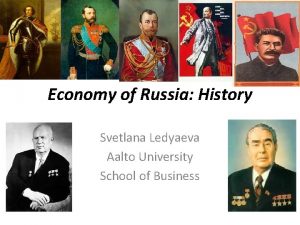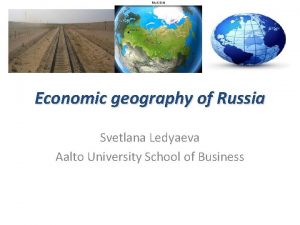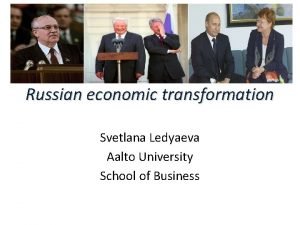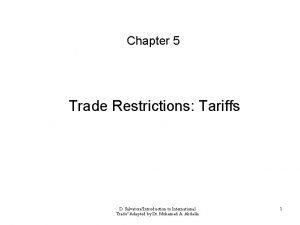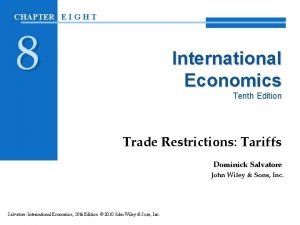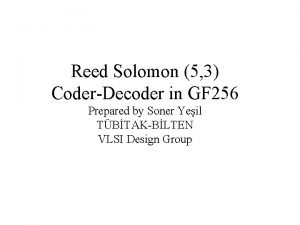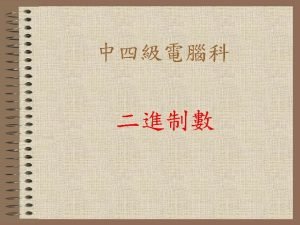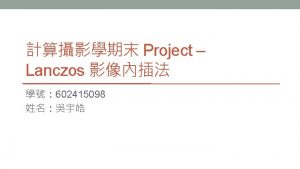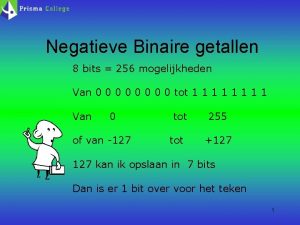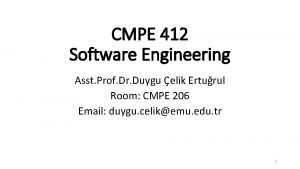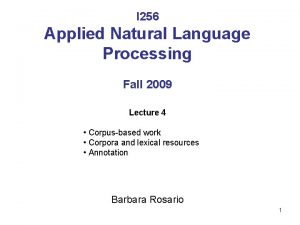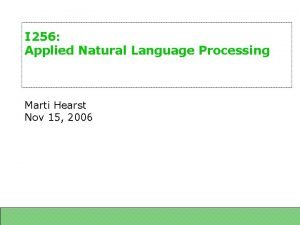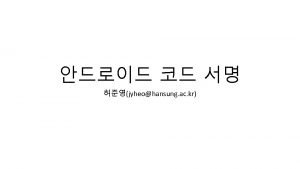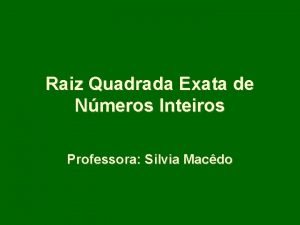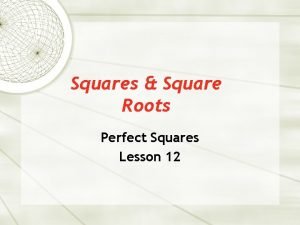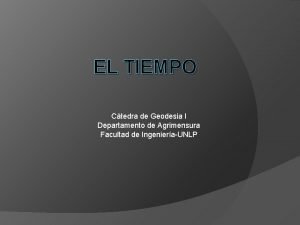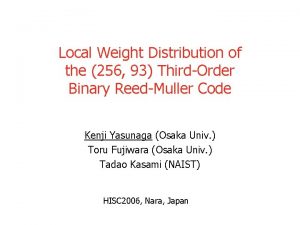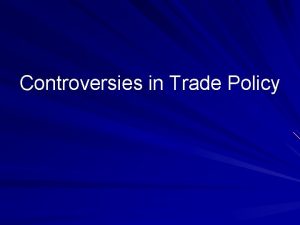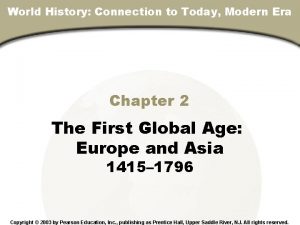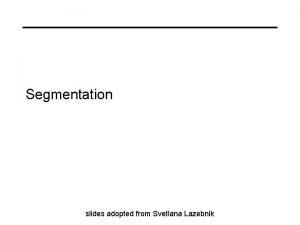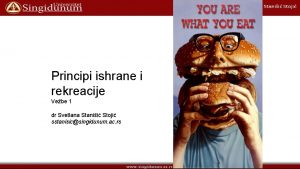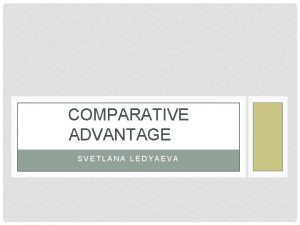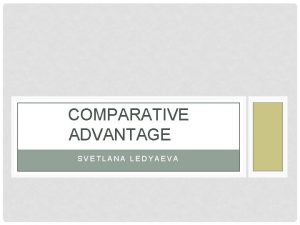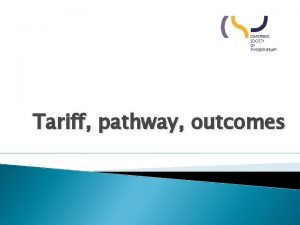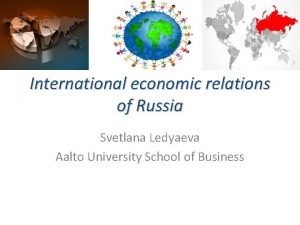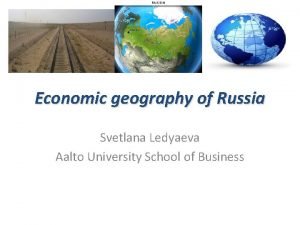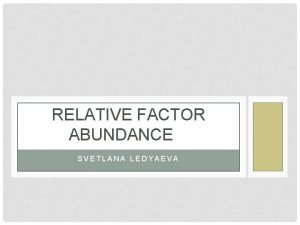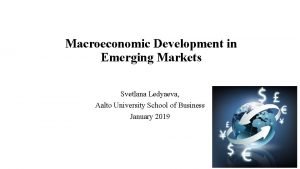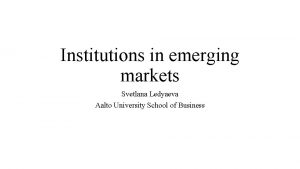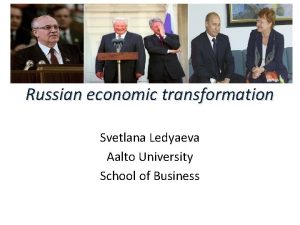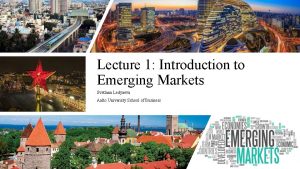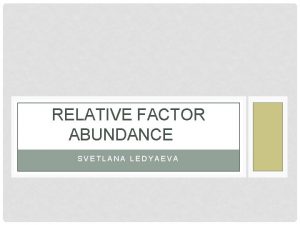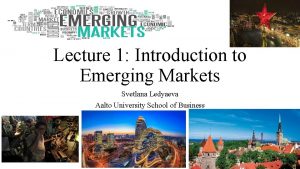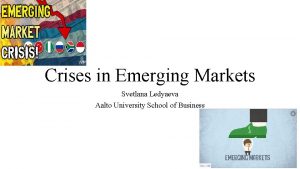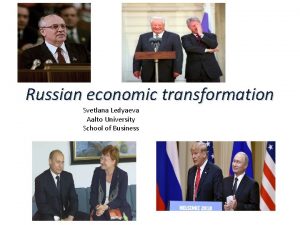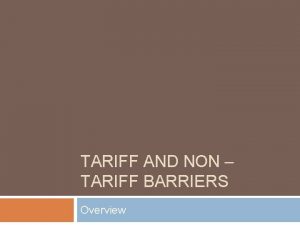TRADE POLICY SVETLANA LEDYAEVA 256 TARIFF ON CHINESE













































- Slides: 45

TRADE POLICY SVETLANA LEDYAEVA

256% TARIFF ON CHINESE STEEL 2/16

QUESTIONS • Why trade restrictions? • Consequences of trade restrictions? Different restriction measures will affect trade flows in different ways. For simplicity we restrict attention mainly to tariffs. 3/16

OTHER TRADE POLICY MEASURES THAN TARIFF Export subsidies (not allowed for WTO members) Export and import quotas Sanitary and phytosanitary (SPS) measures Prohibition for political reasons (Embargo) Lisence

OUTLINE • Partial equilibrium (the tariff industry) - small country - large country • General equilibrium (all industries) - small country - large country • Empirical Evidence

PARTIAL EQUILIBRIUM, SMALL COUNTRY Price demand • Standard partial-equilibrium supply demand supply curve for a good • In autarky, the market clears at pau and qau pau • Suppose that under free trade the world price for this good is pft, lower than pau pft • Consumers demand qdft while producers supply qsft • The difference is imported importft qsft qau from abroad. qdft Quantity

PARTIAL EQUILIBRIUM, SMALL COUNTRY Price demand • Suppose the government supply imposes a tariff T on imports to help domestic producers (protect them against foreign competition) • If the country is small, the pft+T T pft world price will not change but the domestic price will rise to pft+T • As a result, domestic demand importtar falls, supply rises and therefore imports fall qsft qstar qdft Quantity

PARTIAL EQUILIBRIUM, SMALL COUNTRY The government policy seems to work since: • Domestic production expands and foreign competition (imports) falls • What are the welfare costs of this trade policy? • We should distinguish three types of economic agents: • Producers • Consumers • The government

PARTIAL EQUILIBRIUM, SMALL COUNTRY Price demand • Producers gain: supply • Consumers lose: pft+T T pft • Government gains from tariff revenue: importtar T • Net welfare loss: qsft qstar qdft Quantity

PARTIAL EQUILIBRIUM, SMALL COUNTRY • Summary of welfare effects of tariffs for small country: • Producers gain (producer surplus rises) • Government gains (government revenue rises) • Consumers lose (consumer surplus falls) • The gains to producers and the government are completely paid for by the consumers: net welfare falls • The distributional effects have political economy consequences: many consumers suffer a small individual loss, but a few producers benefit from a large individual gain • Conclusion: it is attractive for producers to invest in lobby groups to impose trade restrictions, but not for the many consumers to do the same to try to avoid this • Clearly, politicians should take this into consideration when making their decisions (but it is questionable if they do). Page 10

PARTIAL EQUILIBRIUM, LARGE COUNTRY Price demand • The analysis is quite similar supply for a large country • Difference: tariff reduces imports, and thus total demand for the good, hence ptar+T T pft ptar world price fall to ptar • Price in the tariff-imposing country is then ptar+T qsft qstar qdft Quantity

PARTIAL EQUILIBRIUM, LARGE COUNTRY Price demand • Producers gain: supply • Consumers lose: ptar+T • Government revenue: T pft ptar • Net welfare loss if importtar qsft qstar > qdtar qdft. Quantity and net gain otherwise

PARTIAL EQUILIBRIUM, LARGE COUNTRY Summary of welfare effects of tariffs for large country: • Producers gain • Government gains • Consumers lose (producer surplus rises) (government revenue rises) (consumer surplus falls) • A welfare gain is thus possible • In general, a ‘suitable’ choice of tariff will lead to a welfare gain for a large country: the ‘optimal’ tariff argument • This argument ignores general equilibrium complications and retaliation. Page 13

GENERAL EQUILIBRIUM, SMALL COUNTRY Food pworld • Consider a small labour abundant country with the ppf Ratio of world prices for both goods as drawn below • At the given world price pworld it produces at point Q* and trades Q* at world prices to consume at point C*, reaching welfare U* C* U* ppf 0 Manufactures

GENERAL EQUILIBRIUM, SMALL COUNTRY Food pworld • If the country imposes a tariff t, on pworld(1+t) its import good (manufactures) • Price line for domestic producers clockwise to pworld(1+t) • Production moves to Q 2 Q* Q 2 C* U* 0 Manufactures

GENERAL EQUILIBRIUM, SMALL COUNTRY Food pworld • Partial equilibrium analysis pworld(1+t) already showed output in the protected sector expands • This general equilibrium analysis shows that this comes Q* at the expense of a contraction in the other sector Q 2 C* U* 0 Manufactures

GENERAL EQUILIBRIUM, SMALL COUNTRY Food • The country can still trade with pworld(1+t) ROW at the price pworld • So the available income line is parallel to the initial income line through the new production point Q* Q 2 C* 0 Manufactures

GENERAL EQUILIBRIUM, SMALL COUNTRY Food • Consumers, like producers, pworld(1+t) face the distorted price pworld(1+t) • They consume along the new income at a point like C 2 when their utility curve is tangent to Q* distorted prices. Welfare = U 2 Q 2 C* U 2 0 Manufactures

GENERAL EQUILIBRIUM, SMALL COUNTRY Food • The difference in production pworld(1+t) and consumption income (at domestic prices) represents tariff revenue • We assume that this is redistributed lump-sum to the Q* consumers Q 2 C* U 2 0 Manufactures

GENERAL EQUILIBRIUM, SMALL COUNTRY Food • Note that tariffs result in a pworld double distortion. pworld(1+t) • First, producers change production and thus reduce income at world prices. Welfare U 1 at point C 1 could Q* be attainable Q 2 C 1 C* U* U 1 0 Manufactures

GENERAL EQUILIBRIUM, SMALL COUNTRY Food • Second, consumers are also confronted pworld with distorted prices (domestic prices pworld(1+t) deviate from the world prices), which lowers welfare to U 2 at C 2 • The first reduction in welfare is the production effect, the second is the Q* consumption effect Q 2 C* C 1 U* U 2 0 U 1 Manufactures

GENERAL EQUILIBRIUM, SMALL COUNTRY Summary: • Our general equilibrium analysis for a small country confirms that imposing a tariff always leads to a welfare loss • The increase in output of the protected sector comes at the expense of a reduction of output in the other sector • Imposing a tariff leads to a double distortion as both producers and consumers are faced with distorted domestic prices Page 22

GENERAL EQUILIBRIUM, LARGE COUNTRY A’s import • Consider two large countries America (A) and Britain (B) • Let X be export and M be import; trade balance for A implies: px. XA = p. MMA or MA = p. XA , where p = px/p. M • In trade space (see figure) trade balance is achieved along a line through the origin A import at price p • A can choose any point along this line; in perfect competition producers and consumers choose C the best point available, say C slope = p A export at price p A’s export

GENERAL EQUILIBRIUM, LARGE COUNTRY • An increase in relative price of A’s import export goods to p’ rotates the trade balance line counter-clockwise: relative px • A’s consumers and producers A import at price p’ then choose a different optimal D point, say D • For each relative price A offers a different (optimal) quantity of C exports in exchange for imports slope = p’ A export at price p’ A’s export

GENERAL EQUILIBRIUM, LARGE COUNTRY A’s import • Connecting export offers in A’s offer curve exchange for imports for all prices gives the offer curve • It summarizes all optimal production and consumption decisions in the economy • Moreover, it is possible to derive higher welfare for country A trade indifference curves (see D textbook) • These are tangent to trade balance lines at optimal points (e. g. C and D) and welfare increases for C A to the upper-left corner A’s export

GENERAL EQUILIBRIUM, LARGE COUNTRY • Since what A exports B must B’s export import, we put B’s exports on the vertical axis and B’s imports on the B’s offer curve horizontal axis • The offer curve is therefore curved the other way and welfare increases for B to the lower-right corner B’s import

GENERAL EQUILIBRIUM, LARGE COUNTRY • Combining this information in one A’s import B’s export A’s offer figure, we then see that only at point E B’s offer E the exports A wants to offer in exchange for imports • Match exactly what B wants to offer in exchange for its imports (why not at origin? ) • The slope of the trade balance line through point E determines the free trade equilibrium price p free trade price = p A’s export B’s import

GENERAL EQUILIBRIUM, LARGE COUNTRY A’s import B’s export A’s offer with ‘optimal’ tariff • A’s Offer curve rotate inward with tariff at A’s offer any price (terms of trade), tariff restrict E F B’s offer trade volume. • We can derive the ‘optimal’ tariff for a large country, say A • Taking B’s offer curve as a restriction, A’s welfare is not maximized at point E • Instead, it is maximized at the tangency point F • Country A could potentially have a welfare gain A’s export B’s import

GENERAL EQUILIBRIUM, LARGE COUNTRY A’s import B’s export A’s offer with ‘optimal’ tariff • With simultaneous moves: A A’s offer wants to move from E to F, B wants E F to move from E to G • The end result is a move from E to H with lower welfare for everyone B’s offer • Further retaliation may worsen this outcome need international rules H G and policy coordination in the WTO A’s export B’s import

SUMMARY • Tariff benefits protected producers and provides government revenue at the expense of a welfare loss for the consumers • Imposing a tariff always generates an overall welfare loss for a ‘small’ country • A ‘large’ country might benefit from an ‘optimal’ tariff • These benefits disappear with simultaneous moves and retaliation; hence, the need for international rules Page 30

EMPIRICAL EVIDENCE • Whether a large country can gain from setting an import tariff depends on it’s power to influence international prices • This power may differ by goods/industry • Let’s first see how international prices are determined by import demand export supply curve Page 31

HOME IMPORT DEMAND CURVE Page 32

FOREIGN EXPORT SUPPLY CURVE Page 33

WORLD EQUILIBRIUM E Page 34

EMPIRICAL EVIDENCE • With import tariff, home import demand curve shifts to the left • The magnitude of decrease in price depends on foreign supply elasticity • Elastic supply smaller price change Examples: Hard to find n real life. Firms operating below full capacity. If a car factory is operating at 70% capacity, then it can easily increase supply and produce more cars in response to changes in price. Inelastic supply bigger price change Example: Potatoes in the short term. If the price of potatoes goes up, farmers cannot increase supply because it depends on how many seeds they put in the ground in March. • Hence, import tariff is higher with low elasticity of foreign supply Page 35

BRODA, LIMAO AND WEINSTEIN (AER, 2008): Measure the inverse of the foreign supply elasticity, and show it’s positively correlated with import tariff - use only non-WTO countries

BLW (2008): COUNTRY AVERAGES

BLW (2008): WITHIN COUNTRY ACROSS GOODS Dependent variable: Average tariff at four-digit HS (%) Industry & Conclusion: Theory prediction seems to hold

TYPES OF TARIFFS Ad valorem tariff: a percentage of the value of the product. Specific tariffs are computed on the physical quantity of the good being imported, a tariff of $1. 22/kg on certain types of cheeses. Mixed tariffs are expressed as either a specific or an ad valorem rate, depending on which generates the most (or sometimes least) revenue. Compound tariffs include both ad valorem and a specific component. Tariff rate quotas: very low for import volume until certain threshold; very high after this threshold

WTO – WORLD TRADE ORGANIZATION It is an organization for trade opening. It is a forum for governments to negotiate trade agreements. It is a place for them to settle trade disputes. It operates a system of trade rules. Is a place where member governments try to sort out the trade problems they face with each other.


NOT MEMBERS OF WTO YET Only 12 countries are not WTO members/observers. They are Eritrea, Kiribati, Marshall Islands, Micronesia, Monaco, Nauru, North Korea, Palau, San Marino, Somalia, South Sudan, Turkmenistan, and Tuvalu.

TASK: GRAPH

TASK: QUESTIONS

TASK: ANSWERS 75+40 -125=-10
 Svetlana ledyaeva
Svetlana ledyaeva Svetlana ledyaeva
Svetlana ledyaeva Svetlana ledyaeva
Svetlana ledyaeva Svetlana ledyaeva
Svetlana ledyaeva Svetlana ledyaeva
Svetlana ledyaeva Svetlana ledyaeva
Svetlana ledyaeva Ad valorem tariff vs specific tariff
Ad valorem tariff vs specific tariff Ad valorem tariff vs specific tariff
Ad valorem tariff vs specific tariff Primary 3 malay worksheets
Primary 3 malay worksheets Gf 256
Gf 256 1 256
1 256 Alas sebuah limas berbentuk persegi dengan luas 256
Alas sebuah limas berbentuk persegi dengan luas 256 Vlookup reference error 256 columns
Vlookup reference error 256 columns 2^x=256
2^x=256 Ist 256
Ist 256 8 bit 256
8 bit 256 Cmpe 256
Cmpe 256 I^256
I^256 Quran 2:256
Quran 2:256 I^256
I^256 Manifestversion
Manifestversion Raiz quadrada de 512
Raiz quadrada de 512 Estimating square roots activity
Estimating square roots activity 940 en yakın onluğa yuvarlama
940 en yakın onluğa yuvarlama Sha 256
Sha 256 El año sideral dura 365. 256 días solares medios
El año sideral dura 365. 256 días solares medios Resolución 256 de 2018
Resolución 256 de 2018 256+93
256+93 Trade diversion and trade creation
Trade diversion and trade creation Which is the most enduring free trade area in the world?
Which is the most enduring free trade area in the world? Liner trade and tramp trade
Liner trade and tramp trade The trade in the trade-to-gdp ratio
The trade in the trade-to-gdp ratio Trade diversion and trade creation
Trade diversion and trade creation What was the triangular trade
What was the triangular trade Trade diversion and trade creation
Trade diversion and trade creation Fair trade not free trade
Fair trade not free trade Activist trade policy
Activist trade policy What policy did the qing adopt regarding foreign trade?
What policy did the qing adopt regarding foreign trade? Svetlana lazebnik
Svetlana lazebnik Oksdi
Oksdi Svetlana berdyugina
Svetlana berdyugina Svetlana boginskaja
Svetlana boginskaja Svetlana zhuravleva
Svetlana zhuravleva Bho university
Bho university Svetlana stanišić
Svetlana stanišić Svetlana berdyugina
Svetlana berdyugina
